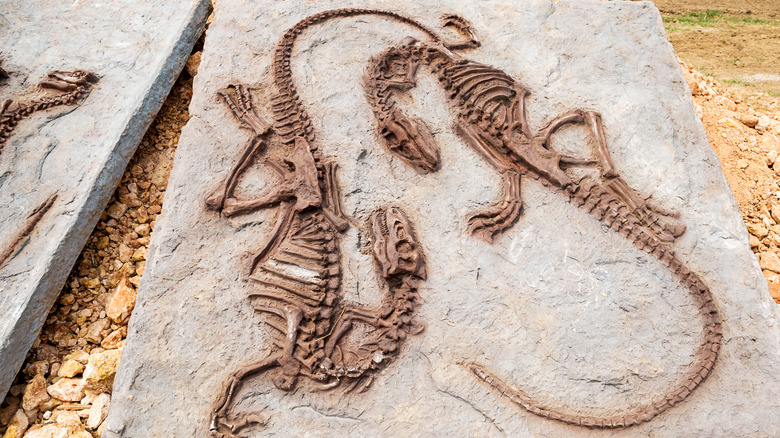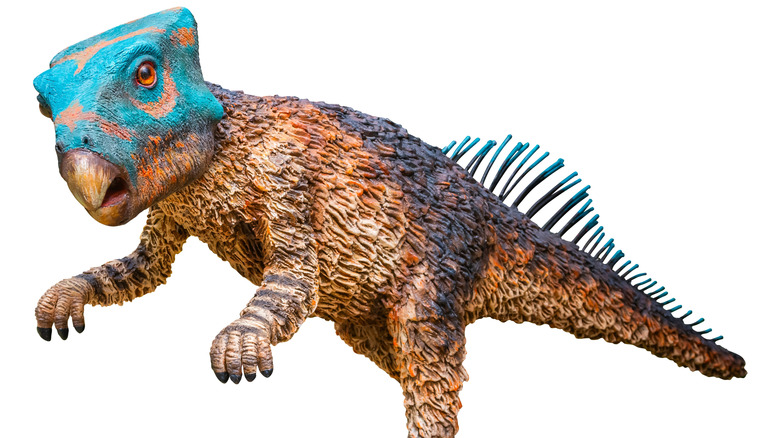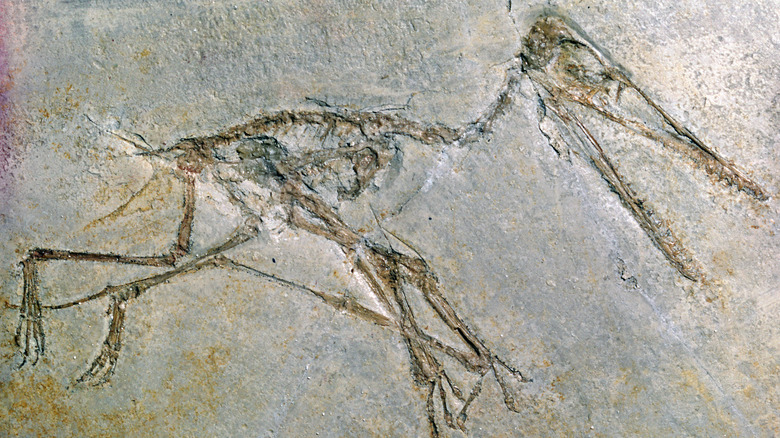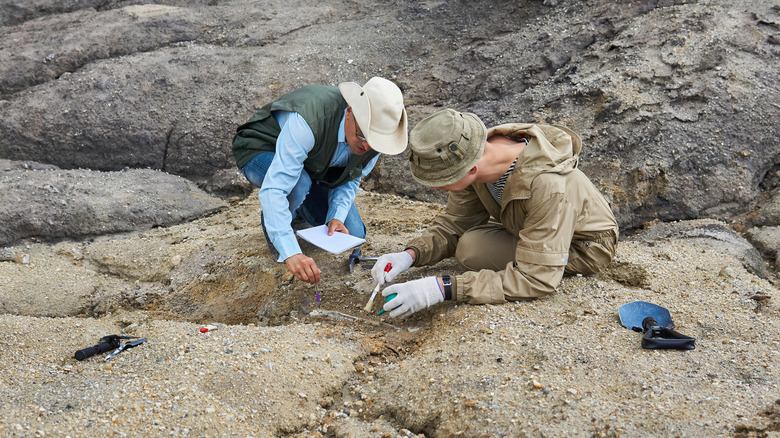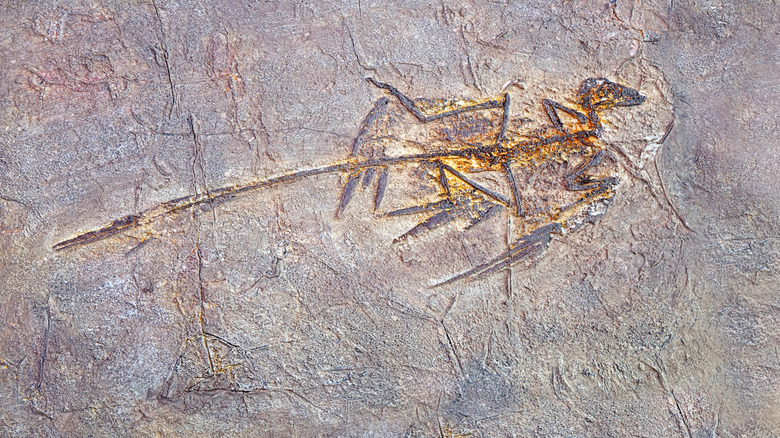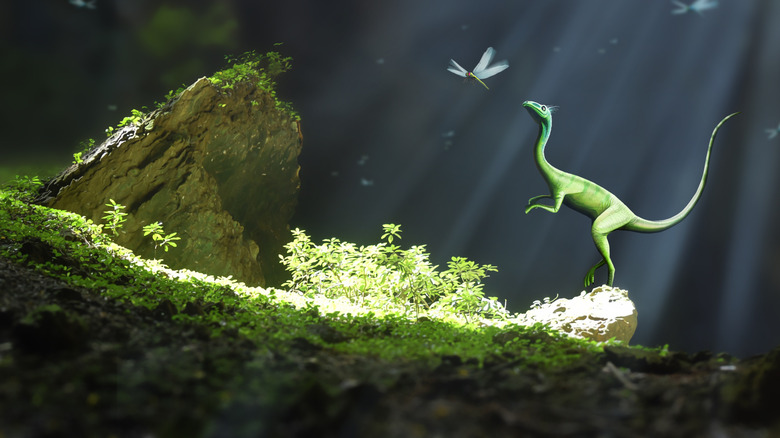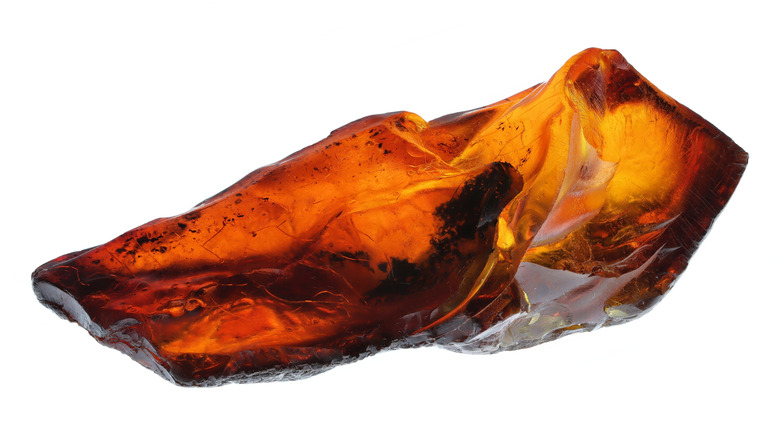7 Of The Smallest Dinosaurs To Ever Exist
When you think of dinosaurs, your first thoughts may include some of the more notorious species. In fact, of the more than 700 dinosaurs scientists have discovered, most people think of the larger species, such as the Tyrannosaurus rex or the Titanosaurs. Aside from wondering what life might be like if the T. Rex was alive today, there are several smaller species of dinosaurs that are also worthy of discovery. These smaller species arguably possess features and characteristics that are just as fascinating (if not more so) than their larger counterparts.
Overall, the smallest dinosaurs that have been discovered and described so far all weighed just under a few pounds and were about the sizes of many of small birds that are alive today. Different small species could also be found across the three time periods the dinosaurs lived in. Many were also feathered and are among some of the animals with wings of the era, but not all of them could fly. It's also worth noting that many (but not all) smaller dinosaurs were theropods, similar to the T. Rex. These types of dinosaurs walked on two feet and were carnivorous. Also, many of the small theropods are considered ancestors to modern-day birds.
Aquilops americanus
First discovered in Montana in 1997, the Aquilops americanus was a small dinosaur that lived during the early Cretaceous era. The dinosaur wasn't officially described until 2014, when paleontologists were able to further study the extracted fossil. It was then that the Aquilops was deemed a new Ceratopsia species. This group of dinosaurs is perhaps best known for their face beaks and their frilled necks, but most of them are also quite large compared with the Aquilops. Scientist have also hypothesized that the Aquilops fossil is just one example of evidence of a possible large migration of horned dinosaurs from modern-day Asia to modern-day North America.
With its name translated as "eagle face," the Aquilops had a beak-shaped face that scientists have described as eagle-like. Such features are considered unique to this particular dinosaur compared to those who lived in the same time period. This small, 3 to 4-pound dinosaur was a relative of the more famous Triceratops. Unlike its large relative that likely weighed 4,000 times more, the Aquilops only measured up to 2 feet long and stood just over 1 foot tall. Scientists are currently unsure of whether the Aquilops can be classified as a therapod like other smaller dinosaurs, or if this creature walked on four legs. And, if you're wondering whether this dinosaur was an herbivore, omnivore, or carnivore animal, the Aquilops was an herbivore that likely ate many different types of plants.
Nemicolopterus
The Nemicolopterus was a flying reptile belonging to a well-known group called pterodactyls ("flying dinosaurs.") Despite its classification, pterodactyls like the Nemicolopterus were not technically dinosaurs, although they are often grouped together as such. Nevertheless, it is worth noting this important discovery that was reported in 2008 in the journal Proceedings of the National Academy of Sciences of the United States of America. The fossil was found in northeastern China, and it is now considered one of the smallest discovered pterodactyls to date.
Likely one of the more adorable small creatures of the Cretaceous period, the Nemicolopterus was a robin-sized reptile that scientists believe resembled a baby bird. With an estimated wingspan of under 10 inches long, the Nemicolopterus could have also looked like a modern-day bat. Unlike bats though, this flying creature used its long fingers to help them take flight, rather than by flapping any wings. The Nermicolopterus was also toothless, and it likely lived in trees within the forested wetlands of the era where it feasted on insects.
Epidexipteryx hui
In the early 2000s, paleontologists discovered another fossilized small species of dinosaur in China. As first reported in 2008 in the journal Nature, scientists named the discovery Epidexipteryx hui. It's thought the dinosaur was comparable in size to a modern-day pigeon. This theropod is also thought to have lived during the middle to late Jurassic period.
Aside from its small stature, the Epidexipteryx had some notable characteristics. First, scientists believe the dinosaur had feathers, but it was also flightless. In particular, researchers found the dinosaur had two pairs of long feathers on its tail at least 20 centimeters (about 8 inches) long, that likely resembled ribbons. These likely did not have any practical uses aside from showing off to other dinosaurs. In fact, Epidexipteryx can be translated to "display feather." The rest of the dinosaur was believed to have shorter feathers along its body that may have looked like fur.
Microraptor
As its name suggests, the Microraptor was related to the well-known Velociraptor, and they were both a part of a group of dinosaurs known as dromaeosaurs. Approximately the size of an average crow, the Microraptor was also a theropod with a long tail and weighing just over 2 pounds. Like other theropods of the era, this dinosaur had feathers and wings. Interestingly, unlike a bird, the Microraptor had wings on its arms and its legs! Scientists later hypothesized that the Microraptor could indeed fly, although there is uncertainty as to whether the dinosaur could use its leg-wings during flight. Instead, some theorize that the Microraptor jumped from tree to tree in search of food, similar to a way a modern squirrel might.
To date, paleontologists have uncovered about 300 Microraptor fossils, which indicates that the small carnivore was quite ubiquitous. It was originally discovered in China, and is believed to have belonged to the early Cretaceous period. Like the Velociraptor, the Microraptor was a carnivorous species, and it primarily feasted on a range of insects, small reptiles, birds, and fish.
Compsognathus
The Compsognathus was a small dinosaur of the late Jurassic period between 145 and 140 million years ago. It grew up to 2 to 3 feet long and weighed up to 12 pounds, and is commonly compared to the size of a modern-day chicken. Ironically, while tiny compared to larger dinosaurs of the Jurassic era, researchers believe the Compsognathus was actually the largest type of dinosaur in its own habitat. This small theropod was originally discovered in the 1800s in both France and Germany. Most recently, a fossil of one of its close relatives was also found in China.
One of the most notable features of the Compsognathus was its running capabilities. Despite its small size, the theropod could run very quickly thanks to its lean build, long neck, and strong legs. Such characteristics likely helped the Compsognathus hunt. The dinosaur was a carnivore, and it likely ate lizards and other smaller prey. Also, unlike other theropods of the era, paleontologists have yet to confirm that the Compsognathus actually had feathers.
Anchiornis huxleyi
The Anchiornis huxleyi was one of the many feathered dinosaurs that likely lived within the climate of the Jurassic era. It was also a theropod who walked on two legs instead of four. Despite having small wings, these likely helped the Anchiornis huxleyi glide over shorter distances only, rather than flying. Nevertheless, this species is considered the most ancient soaring dinosaur fossil to date, having been discovered in northern China in 2009.
Scientists believe this species lived between 165 and 153 million years ago. It was also another small dinosaur, measuring just 0.6 meters (less than 1 foot) in length, and had a frame similar to a bird. In fact, this late Jurassic period dinosaur was comparable to the size of a modern-day crow. Unlike crows, which are omnivorous, the Anchiornis huxleyi is thought to have been carnivorous and mostly ate a diet of fish and lizards, as well as some insects. Researchers have even been able to hypothesize possible colorings on the body of this dinosaur, ranging between gray and black, and with red crown-like feathers on its head. Some even believe it may have looked similar to a modern red-headed woodpecker.
Oculudentavis khaungraae
In 2020, the Oculudentavis khaungraae was considered the most recently discovered small dinosaur species, but with a few caveats. Per published findings in Nature, this bird-like creature was also the smallest dinosaur to be discovered in the Mesozoic era. Remarkably, a team of researchers in Myanmar found a perfectly preserved O. khaungraae skull within amber, and was considered a true-form fossil of the four types of fossils more generally. Overall, the O. khaungraae fossil is estimated to be at least 99 million years old. Nicknamed the "eye-tooth bird" for its numerous teeth and extremely large eyes for its body size, the O. khaungraae was only about the size of a modern-day bee hummingbird.
Regardless of its size though, scientists believe the O. khaungraae was actually a formidable predator that targeted a variety of insects that it likely devoured easily with its sharp teeth. As such, scientists gave what the creature another nickname: "the cretaceous terror of insects." Since the original findings though, the authors did print a retraction in July 2020, which pointed to O. khaungraae as possibly being a lizard, and not a dinosaur. More analyses are likely needed to better understand the O. khaungraae.
